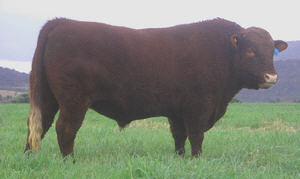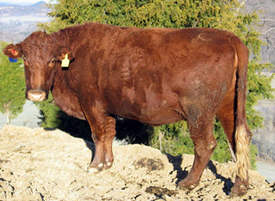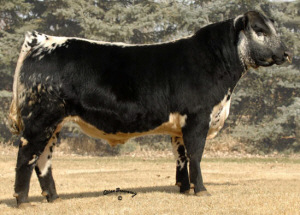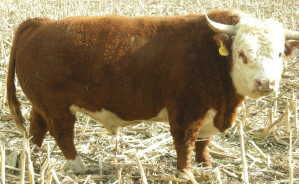



Devon
History
The Devon, sometimes called North Devon, to distinguish it from the South Devon breed, is one of the oldest beef breeds in existence today. In fact some authorities consider the Devon's origin to be prehistoric, the assumption being that the breed descended directly from Bos lonqifrons, the smaller type of aboriginal cattle in Britain. According to an offical reference material compiled by the Devon Cattle Breeders Society, Somerset, England; Devon Cattle - The Red Rubies, it appears that the Red Cattle of North Devon may have contributed to the Hereford and other British breeds.The Devon was previously classified as a dual-purpose breed. Over the past half century, however, the breed has, through selection, evolved as a beef-type breed which is registered and promoted by the Devon Cattle Association, Inc. A Milking Devon strain (unique to America) has been maintained and is represented by the American Milking Devon Cattle Association.
 |
| Photo courtesy of Wallaton Devon Stud, www.wallatondevons.com.au |
The early improvers of the Devon breed were Francis Quartly and his brothers William and Henry, and John Tanner Davy and his brother William. It is generally agreed that Francis Quartly accomplished for the Devon what the Collings did for the Shorthorn.
Only 131 years after Columbus discovered North America, the first Devon cattle reached what is now the United States. The year was 1623. The ship Charity brought a consignment of red cattle (one bull and three heifers) from Devonshire to Edward Winslow, the agent for Plymouth Colony. These red cattle of Devonshire, brought in by the Pilgrims, were probably the first purebred cattle to reach North America.
During its long history in the United States, numerous breeders have been instrumental in bringing the Devon in America to a high degree of excellence. From the earlier dual-purpose type, beef conformation has been enhanced while retaining adequate milk production. Rate of maturity has been accelerated. The more common criticisms of light hindquarters and sickle hocks have been reduced to minimum. And, in keeping with newer concepts in America of "ideal" beef form, Devons have been made longer, taller, and trimmer but, fortunately, not to extremes as is true for some "exotic" breeds.
Although the Devon was originally a horned breed, American stockmen developed a polled strain of purebred Devons. It traces back to the bull Missouri 9097, a hornless "sport" or mutation that was born in 1915 in the purebred Devon herd owned by Case and Elling in Concordia, Missouri.
Characteristics
 |
| Photo courtesy of Roffey Cattle Company, www.americandevon.com/roffey |
Modern Devons are of an adequate size and scale. mature bulls in good working condition weigh from 1700 to about 2200 pounds with a few in top flesh condition exceeding the later figure. Mature cows range in weight from about 950 to about 1300 pounds.
Calving problems are seldom encountered although a growing stress on using larger bulls has increased the incidence of difficult births. Male calves average about 75 pounds at birth but may range from about 55 to 95 pounds. Heifer calves average about 70 at birth but may range from about 45 to 90 pounds.
The breed has long been noted for its fertility, calving ease, docility, hardiness and ability to adapt to temperature extremes. The well-developed heat-regulating mechanism of the scrotum of Devon bulls give them an unusual ability to remain fertile despite extremely high environmental temperatures.
Devon have the thickest hides of any cattle in the world. That means that Devon cattle have better resistance to external parasites.
They produce high quality meat in a wide range of production systems, from intensive feedlot or grass finishing to the extensive pastoral run.
Statistics
- Early maturity
- Excellent performance on natural grass based systems
- High daily weight gain
- Docility
- Outstanding mothering and milking ability
- Beef with excellent flavour and tenderness
- Tolerant of hot or bleak climates
- Natural resistance to disease
- An outstanding terminal sire
- Gestation Length (day) -0.06
- Calving Ease -1.80
- Birth Weight (kg) +0.45
- Milk (kg) +1.60
- 200 Day Growth (kg) +8.70
- 400 Day Growth (kg) +19.30
- Muscle Score +0.17
- Muscle Depth (mm) -0.02
- Fat Depth (mm) -0.20
Comparative
Distribution
Their ability to efficiently utilize grass and other forages has heightened their popularity in areas like southern Brazil, Australia, and New Zealand.They are also well known in Europe and the USA.
References (the above information was cited from the following sites)
www.redrubydevon.co.uk
www.ansi.okstate.edu
www.devoncattle.co.nz
www.wallatondevons.com.au
www.americandevon.com/roffey


